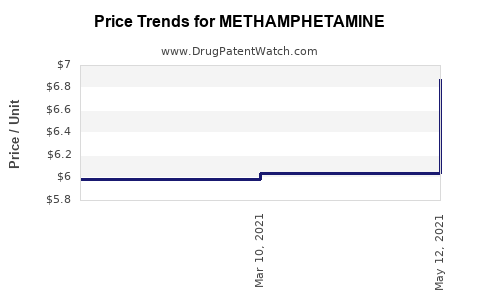Drug Price Trends for METHAMPHETAMINE
✉ Email this page to a colleague

Average Pharmacy Cost for METHAMPHETAMINE
| Drug Name | NDC | Price/Unit ($) | Unit | Date |
|---|---|---|---|---|
| METHAMPHETAMINE 5 MG TABLET | 68308-0115-01 | 9.29211 | EACH | 2024-11-20 |
| METHAMPHETAMINE 5 MG TABLET | 68308-0115-01 | 8.20896 | EACH | 2024-10-23 |
| >Drug Name | >NDC | >Price/Unit ($) | >Unit | >Date |
Best Wholesale Price for METHAMPHETAMINE
| Drug Name | Vendor | NDC | Count | Price ($) | Price/Unit ($) | Unit | Dates | Price Type |
|---|---|---|---|---|---|---|---|---|
| METHAMPHETAMINE HCL 5MG TAB | Golden State Medical Supply, Inc. | 68308-0115-01 | 100 | 696.98 | 6.96980 | EACH | 2023-06-16 - 2028-06-14 | FSS |
| DESOXYN 5MG TAB | Recordati Rare Diseases, Inc. | 55292-0104-01 | 100 | 677.27 | 6.77270 | EACH | 2022-01-01 - 2026-04-14 | Big4 |
| DESOXYN 5MG TAB | Recordati Rare Diseases, Inc. | 55292-0104-01 | 100 | 677.27 | 6.77270 | EACH | 2022-01-01 - 2026-04-14 | FSS |
| DESOXYN 5MG TAB | Recordati Rare Diseases, Inc. | 55292-0104-01 | 100 | 730.09 | 7.30090 | EACH | 2023-01-01 - 2026-04-14 | Big4 |
| DESOXYN 5MG TAB | Recordati Rare Diseases, Inc. | 55292-0104-01 | 100 | 730.09 | 7.30090 | EACH | 2023-01-01 - 2026-04-14 | FSS |
| DESOXYN 5MG TAB | Recordati Rare Diseases, Inc. | 55292-0104-01 | 100 | 730.09 | 7.30090 | EACH | 2024-01-01 - 2026-04-14 | Big4 |
| DESOXYN 5MG TAB | Recordati Rare Diseases, Inc. | 55292-0104-01 | 100 | 686.07 | 6.86070 | EACH | 2021-04-15 - 2026-04-14 | Big4 |
| >Drug Name | >Vendor | >NDC | >Count | >Price ($) | >Price/Unit ($) | >Unit | >Dates | >Price Type |


